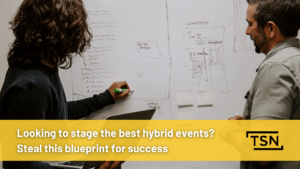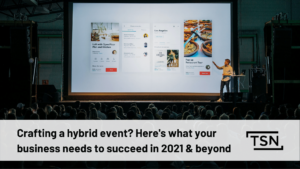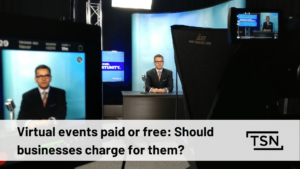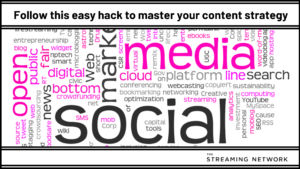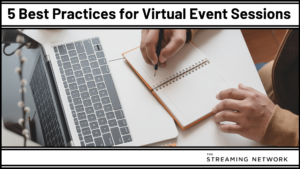Many of our clients talk to us about the struggles they have producing fresh content on a regular basis. Our advice is often to revisit existing material like an eBook or podcast that may be just sitting on your website, collecting digital dust. You can breathe new life into these materials and jump start your business’s content strategy by reimagining, recycling and repurposing these into fresh content assets.
Today, marketing requires content to be created on a regular publishing cycle. For many marketing departments, this can stretch resources to the breaking point. In a survey, it was found that 67 per cent of marketers produce content daily, such as podcasts or social posts.
Repurposing, however, save you a considerable amount of resource allocation, allows you to reiterate your message in new and creative was, and safeguards your team’s sanity. Moreover, it does wonders for your SEO ranking.
Here at The Streaming Network, we practice what we preach – this blog, for example, is based on a video that we previously posted on The Streaming Network site and YouTube. That video was, in fact, taped as part of our The Webinar: Lessons from the Front Line podcast, which itself was cut into bit-sized segments for social channels. That single podcast generated over a dozen short- and long-form pieces of audio, video and text-based content.
We like to think that with a little planning, you can do something similar.
So, how can you repurpose your materials and flesh out a content strategy for your business? We’re so glad you asked. Using a PowerPoint deck that we developed for client pitches as a blueprint, we’ll give you a step-by-step rundown of how it can be done.
Find your “Rock” content
The first step to repurposing your content on a consistent basis is to find or produce a foundational piece. This is called your “rock” content – a substantial piece of content from which you will chip other pieces of content. This should be a definitive guide to a conversation that you want to own.
Here at The Streaming Network, that larger piece of content was our Return on Investment (ROI) presentation.
Why did we create it? During a data-driven research phase and needs analysis, we saw an opportunity: if businesses were going to invest in robust virtual events and webinar software packages (such as what The Streaming Network offers), they needed to be able to gauge its ROI, before committing. The returns need to justify the cost.
Do your research and find out what sort of challenges our target market is dealing with as it relates to your products or services. This will help you determine the direction of your rock content.
Like any other piece of thought leadership content though, your foundational piece will have a shelf-life – roughly two years. But it can vary. In our situation, we were able to extract more for longer because it is such an evergreen topic.
Once you’ve squeezed all the juice out of your foundational piece, instead of letting it wilt away, you’ll want to slice it up and turn it into further assets – digital, written or interactive.
Create and build upon your content assets
After creating the ROI presentation, we received some great customer stories about how they were getting ROI, incorporating the data and best practices we had provided them the year before. The lightbulb went off and we knew that we had something we could build upon.
Enter the ROI webinar. We decided to wrap up our presentation and relate it to our key customers, since we were going into renewal meetings at the time. We benchmarked their companies against the index and brought forth stories, linking them to how big businesses were getting ROI.
With this webinar, we had to suss out the correlation between having a webinar program and revenue, as it is not necessarily a straight line like sales. Amon other things, we highlighted the importance of running virtual events more than once throughout the year, since new people are always searching for your topic.
We created three different intros for three different webinars, each focusing on a specific audience we were targeting. Clips from the webinar were posted on our YouTube page and on The Streaming Network site.
This inadvertently sparked another content opportunity. An outside marketer saw our webinar and wrote about it in a blog; he reached out to us about posting it and wanted us to review it.
Taking inspiration from this, we converted our ROI presentation into several more blog posts. If you have the resources to create them, we highly recommend these as content pieces.
It was at that point that we realized we had enough blog content to compile everything into an eBook, “The Smart Marketer’s Guide to ROI,” a how-to guide that also included videos and pictures from our initial ROI presentation. In short order, we had repurposed our original rock content into several valuable content assets, building upon each one. It’s also been the source material for several podcasts.
Leverage interactivity when possible
One of our top performing pieces to this day is the interactive Webinar Report Card, which builds upon the success of our ROI presentation.
The report card tests the maturity of people’s webinar programs and asks for specific numbers – conversions, engagements and so on. Based on where they are on the benchmark, we provide them with suggestions as well as video clips from our ROI webinar and pointers from our eBook.
Including these sorts of interactive content pieces is a great way to feed your business’s sales pipeline.
Final thoughts
While the specifics will vary from vertical to vertical and business to business, repurposing your material remains an excellent method to boosting your overall content strategy.
The important thing is to go deep into an idea, get it out in front of customers and see if it is resonating. Once it is, you can create strong rock content that will help fuel your content strategy.
If you’re struggling for ideas, get inspiration for your content from the people on the front line, such as your sales team, as they are getting the same questions all the time. We’ve discussed this recently in our best practices for virtual event sessions, but it is just as applicable here.
If you need more help with your next webinar or virtual event, whether it be setting it up or creating engaging content, reach out to the experts at The Streaming Network today! And check out our state of the art Engage Webinars platform.
We’re passionate about creating compelling virtual events that people want to attend.

